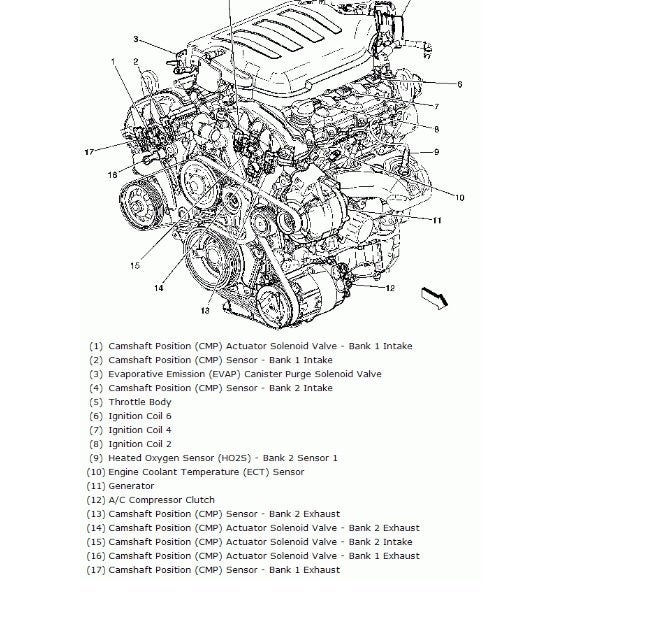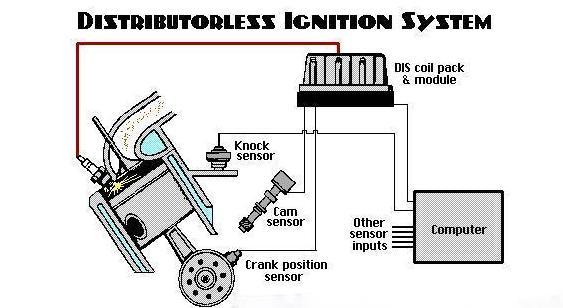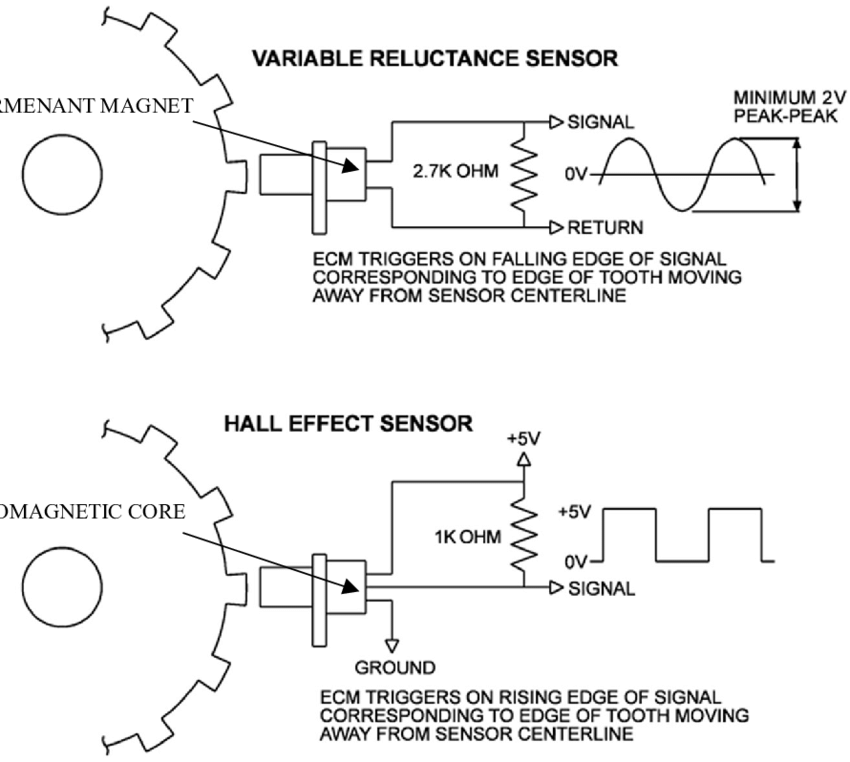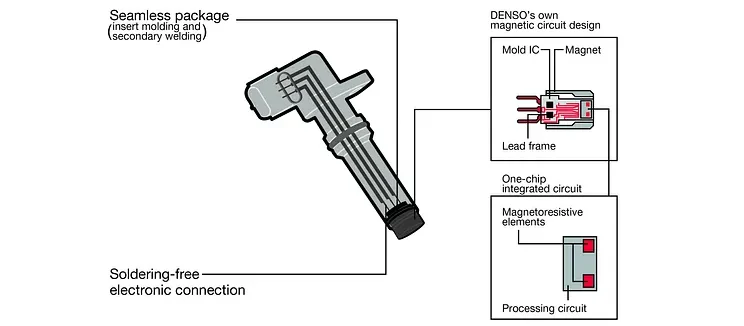In the intricate dance of engine components, the camshaft plays a crucial role in dictating the timing of various events within the combustion process. Camshaft Position Sensors, powered by Hall Effect technology, are the unsung heroes behind the scenes, ensuring that the engine performs with precision and efficiency. Now that, we delve into the fascinating world of Hall Effect sensors and their integral role in determining the position and speed of the camshaft.
What is a Camshaft Position Sensor?
The Sentinel’s Purpose
At its core, the Camshaft Position Sensor is a sophisticated electronic entity designed to be the eyes and ears of the engine. Its primary task is to monitor, with unparalleled precision, the dynamic rotation and speed of the camshaft. This real-time vigilance is not a mere formality; it is the key that unlocks the potential for the ECM to orchestrate seamless adjustments in fuel injection and ignition timing.

A Symphony of Information
Picture the camshaft as the conductor, dictating the symphony of combustion within the engine. The Camshaft Position Sensor, perched strategically in the orchestra, captures every nuance of the camshaft’s movement. It transforms these intricacies into a language the ECM understands – a language that speaks volumes about the engine’s health and efficiency.
Fuel Injection and Ignition Timing: The Dance Partners
In the grand ballroom of combustion, fuel injection and ignition timing are the dance partners that must waltz in perfect harmony. The Camshaft Position Sensor provides the crucial cues, allowing the ECM to choreograph these movements with the finesse of a seasoned dance instructor. The result? An engine that not only purrs with efficiency but roars with power when demanded.
The Hall Effect Phenomenon
At the heart of Camshaft Position Sensors lies the Hall Effect, a fundamental physics principle discovered by Edwin Hall in 1879. When a magnetic field is applied perpendicular to the flow of an electric current in a conductor, it induces a voltage perpendicular to both the current and the magnetic field. This voltage, known as the Hall voltage, is proportional to the strength of the magnetic field.
The Hall Effect Sensor in Camshaft Position Sensing
Construction of Hall Effect Sensor:
Hall Effect sensors typically consist of a small semiconductor chip, often made of gallium arsenide or similar materials, through which a constant electrical current flows. This current is applied perpendicular to the direction of the magnetic field the sensor is designed to detect. On the semiconductor chip, there is a Hall voltage proportional to the strength of the magnetic field. This voltage is then measured to determine the magnetic field’s intensity.
Installation and Operation:
In the specific case of camshaft position sensing, a magnet is securely mounted on the camshaft. This magnet rotates with the camshaft, generating a dynamic magnetic field. The Hall Effect sensor is strategically positioned in close proximity to the rotating camshaft and magnet. As the camshaft turns, the magnetic field around the sensor changes, causing the semiconductor material to produce a voltage signal.

Hall Effect Sensor:
Positioned in close proximity to the rotating magnet is a Hall Effect sensor. The Hall Effect is a physics phenomenon where a voltage difference is created across an electrical conductor perpendicular to the flow of an electric current in the presence of a magnetic field.
The Hall Effect sensor essentially consists of a semiconductor material through which current flows. As the magnetic field from the camshaft’s magnet influences this semiconductor material, it induces a voltage that is proportional to the strength of the magnetic field.
Voltage Pulse Generation:
The changes in the magnetic field induce fluctuations in the Hall voltage, creating a series of voltage pulses. These pulses are directly related to the rotational movement of the camshaft. The frequency of these pulses corresponds to the speed of the camshaft, while the amplitude reflects the strength of the magnetic field. This information is then sent to the Engine Control Module (ECM) for processing and interpretation.
ECM Interpretation:
The ECM, or engine control module, is the central brain of the vehicle’s engine management system. It receives the voltage pulses from the Hall Effect sensor and interprets them to accurately determine the camshaft’s position and speed. By analyzing the frequency and amplitude of the pulses, the ECM can precisely time the opening and closing of the engine’s valves, optimizing fuel injection and ignition timing.

Engine Timing and Performance:
Accurate camshaft position information is critical for achieving optimal engine timing. Proper timing ensures that the intake and exhaust valves open and close at the right moments, allowing for efficient air-fuel mixture combustion.
The camshaft position sensor thus contributes to improved fuel efficiency, reduced emissions, and enhanced overall engine performance.
Diagnostics and Fault Detection:
In addition to real-time engine control, the camshaft position sensor aids in on-board diagnostics. If there is a malfunction or irregularity in the sensor’s signals, the ECM can trigger a diagnostic trouble code (DTC), indicating a potential issue that requires attention.
Importance of Camshaft Position Sensing
Precision Timing for Combustion
The proper functioning of an internal combustion engine relies on precise timing. The camshaft position sensor ensures that the opening and closing of engine valves occur at the right moment, optimizing combustion efficiency and power output.
Fuel Efficiency and Emissions Control
Accurate camshaft position sensing allows the ECM to adjust the timing of fuel injection, promoting optimal fuel-air mixture combustion. This not only enhances fuel efficiency but also aids in controlling emissions, contributing to a cleaner environment.
Challenges and Innovations
Environmental Factors and Sensor Reliability:
Temperature Sensitivity: One significant challenge faced by Hall Effect sensors is their sensitivity to temperature variations. Extreme temperature conditions can affect the accuracy of sensor readings, potentially leading to errors in camshaft position detection. Ongoing research focuses on developing temperature-resistant materials and innovative sensor designs to mitigate this issue.
Electromagnetic Interference (EMI): In today’s electronically dense automotive environments, EMI can pose a significant threat to sensor performance. Researchers are actively working on shielding techniques, signal processing algorithms, and improved sensor materials to enhance resistance against electromagnetic interference. This ensures stable and accurate readings even in the presence of other electronic components within the vehicle.
Innovations in Sensor Technology:
Smart Sensor Networks: The integration of smart sensor networks is a cutting-edge approach to enhance the reliability of camshaft position sensors. These networks allow sensors to communicate with each other, cross-verify data, and compensate for any discrepancies. This not only improves accuracy but also contributes to the overall robustness of the sensing system.
Self-Calibration Mechanisms: To address environmental factors and potential sensor drift over time, self-calibration mechanisms are being explored. These mechanisms enable sensors to recalibrate themselves periodically, ensuring consistent and accurate camshaft position readings throughout the sensor’s lifespan.
Integration with Variable Valve Timing (VVT) Systems:
Optimizing Engine Performance: The integration of Camshaft Position Sensors with Variable Valve Timing (VVT) systems represents a groundbreaking advancement. VVT systems dynamically adjust the timing of the opening and closing of engine valves, optimizing combustion efficiency and power delivery. This integration allows for precise control over the engine’s performance, enhancing fuel efficiency, reducing emissions, and improving overall driving experience.
Adaptive Algorithms: Innovations in control algorithms play a crucial role in maximizing the benefits of VVT integration. Advanced adaptive algorithms analyze real-time data from camshaft position sensors, along with other engine parameters, to make instantaneous adjustments to valve timing. This adaptability ensures optimal performance under varying driving conditions, from idling to high-speed acceleration.

Future Prospects:
Miniaturization and Integration: Continued efforts are being made to miniaturize sensor components, making them more compact and lightweight. This not only aids in easy integration into modern engine designs but also contributes to overall vehicle weight reduction, thereby improving fuel efficiency.
Advanced Materials: Research is ongoing to explore advanced materials with improved resistance to environmental factors. This includes the use of materials that can withstand extreme temperatures, resist corrosion, and provide enhanced durability, ensuring a longer lifespan for camshaft position sensors.
In the intricate ballet of an internal combustion engine, Camshaft Position Sensors powered by Hall Effect technology take center stage, ensuring that every movement is choreographed with precision. As automotive engineering continues to evolve, these sensors will undoubtedly play a pivotal role in enhancing efficiency, performance, and environmental sustainability. The Hall Effect’s magic, once confined to the realm of physics laboratories, now manifests itself on the road, orchestrating the symphony of the modern automobile engine.
Learn more Throttle Position Sensors and Wheel Speed Sensors











